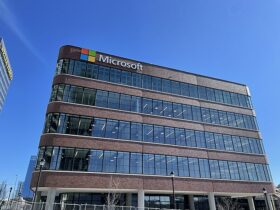The U.S. cybersecurity firm acknowledged on Wednesday {{that a}} sprawling cyber espionage advertising marketing campaign made public earlier this month is affecting state and native, although it launched few additional particulars.
The hacking advertising marketing campaign, which used U.S. tech agency SolarWinds as a springboard to penetrate federal authorities networks, was “impacting enterprise networks all through federal, state, and native governments, along with important infrastructure entities and completely different personal sector organizations,” the Cybersecurity and Infrastructure Security Firm (CISA) acknowledged in a press launch posted to its web page.
The CISA acknowledged the ultimate week that U.S. authorities companies, important infrastructure entities, and private groups had been amongst these affected. Nevertheless, they did not significantly level out state or native our bodies. Thus far, solely a handful of federal authorities companies have formally confirmed having been affected, along with the U.S. Treasury Division, the Commerce Division, and the Division of Energy.
CISA did not decide the state or native companies affected and did not immediately return an email looking for the uncover’s an additional ingredient.
Reuters has reported that Pima County, Arizona, was among the many many victims of the wave of intrusions.
The county did not immediately return a message looking for comment late Wednesday. Beforehand, the county’s chief knowledge officer suggested to Reuters his crew had taken its SolarWinds software program offline immediately after the hack grew to develop into public and that investigators had not found any proof of an additional compromise.
Senior U.S. officers and lawmakers have alleged that Russia is at cost for the hacking spree, a price the Kremlin denies.
To understand the place the SolarWinds attackers are going subsequent, and how one can defend in opposition to them, look to the clouds.
The SolarWinds present chain assaults are unprecedented in some methods. The assaults are delicate in execution, broad in scope, and intensely potent of their effectiveness. Nevertheless, the most notable technique is the unprecedented technique by which the SolarWinds attackers look for entry to cloud-based suppliers as one of their key targets.
That’s becoming clearer as new tales clarify knowledge obfuscated by the technical jargon in early incident tales’ ultimate week.
On Monday, the New York Cases reported that “[t]he Russian hackers who penetrated United States authorities companies broke into the email system utilized by the Treasury Division’s most senior administration.” This follows a report from Reuters on Dec. 13, saying, “[h]hackers broke into the [National Telecommunications and Information Administration] NTIA’s office software program program, Microsoft’s Office 365. the hackers had monitored employees’ emails on the corporate or months, sources acknowledged.”
These tales, combined with technical particulars launched by Microsoft and the Nationwide Security Firm (NSA) beforehand week, {Show} how the SolarWinds attackers have made specializing in cloud-based suppliers a key purpose of their assaults. Significantly, if we decode the numerous tales and be part of the dots, we’ll see that the SolarWinds attackers have centered authentication methods on the compromised networks to permit them to log in to cloud-based suppliers like Microsoft Office 365 without elevating alarms. Worse, one of the simplest ways they’re carrying this out can doubtlessly be used to appreciate entry to many, if not all, of an organization’s cloud-based suppliers.
This tells us that attackers have tailor-made their assault methodology to match the hybrid on-premises/cloud environments many organizations now have, which implies that responders to the SolarWinds assaults should look not merely at their methods and networks however as well as at their cloud-based suppliers for proof of compromise. This moreover signifies that defenders need to lengthen the protection and monitoring of their cloud suppliers’ authentication methods and infrastructure any extra.
We’ll uncover the technical particulars beneath, nevertheless listed below are the essential factor takeaways:
One of the many key actions SolarWinds attackers take after establishing a foothold on networks is to give attention to the methods that topic the proof of id utilized by cloud-based suppliers and steal the means to topic IDs.
As quickly as they’ve this, they’ll use it to create fake IDs that enable attackers to impersonate respectable prospects or create malicious accounts that seem respectable, along with accounts with administrative (i.e., full) entry.
On account of these IDs are used to current entry to info and suppliers by cloud-based suppliers, the attackers are ready to enter info and email similar to respectable prospects, along with these with full entry, and they also obtain this.
This can be very potential that that’s how the SolarWinds attackers gained entry to Treasury and NTIA’s email methods: they leveraged the neighborhood compromise to get admission to cloud-based suppliers. In precise reality, considered one of many Microsoft postings regarding the SolarWinds assault talks about “Defending Microsoft 365 from on-premises assaults,” which really means, “How one can maintain your neighborhood compromise from turning proper right into a cloud-services compromise, as correctly.”
What’s SAML, and why does it matter?
To understand this aspect of the SolarWinds assaults, it’s important to know that SAML stands for “Security Assertion Markup Language.” It’s a method for authentication (i.e., logging on) utilized in cloud-based suppliers. A “SAML token” is the exact “proof” to the service that you just’re who you say you are.
Specialists in cloud or authentication utilized sciences gained uncover the Treasury or NTIA developments surprising: Microsoft made this aspect clear in every its postings on Dec. 13: “Purchaser Guidance on Present Nation-State Cyber Assaults” and “Essential steps for patrons to protect themselves from present nation-state cyberattacks.” Every posting have associated language:
The intruder “makes use of the chief permissions acquired by the on-premises compromise to appreciate entry to the group’s worldwide administrator account and/or trusted SAML token signing certificates. This permits the actor to forge SAML tokens that impersonate any of the group’s current prospects and accounts, along with extraordinarily privileged accounts.”
“Anomalous logins using the SAML tokens created by the compromised token signing certificates can then be made in opposition to any on-premises sources (regardless of id system or vendor) along with to any cloud ambiance (regardless of vendor) because they have been configured to perception the certificates. On account of the SAML tokens are signed with their very personal trusted certificates, the group could also miss the anomalies.”
Within the meantime, on Dec. 18, the NSA launched a directive on “Detecting Abuse of Authentication Mechanisms.” Whereas not specifically respond to the SolarWinds assaults, it discusses SAML assaults and locations the SolarWinds assaults throughout the context of these assaults, which have been spherical since 2017.
Information is scattered all through all of these postings; nevertheless, collectively, they make clear that:
One of the many key actions SolarWinds attackers are taking after they arrange a foothold on networks is to “[steal] the certificates that indicators SAML tokens from the federation server (ADFS), generally known as a Token Signing Cert (TSC).” [Source]
As quickly as they’ve this, it lets them “forge SAML tokens to impersonate any of the group’s current prospects and accounts, along with extraordinarily privileged accounts.”
On account of “[d], ata entry has relied on leveraging minted SAML tokens to entry individual info/e-mail or impersonating the Functions or Service Principals by authenticating and buying Entry Tokens using credentials that had been added…[t]he actor periodically connects from a server at a VPS provider to entry specific prospects’ emails using the permissions granted to the impersonated Utility or Service Principal.” [Source]
What does this suggest?
Nothing proper right here is new or surprising for security professionals: full entry to a neighborhood means you’ll be able to do one thing you want with it. Moreover, the NSA doc notes these assaults have been seen since 2017. Nevertheless, that’s the major important assault with this sort of broad visibility that targets cloud-based authentication mechanisms. That, combined with the technical jargon in these tales, signifies that many people haven’t, however, associated these dots.
It doesn’t help that quite a lot of the dialogue of this aspect has been unclear. Some tales have indicated a vulnerability affecting Microsoft’s providers or merchandise involved throughout the Treasury or NTIA email intrusions. I requested Microsoft if there have been any vulnerabilities involved, and they also responded: “Now we have not acknowledged any Microsoft product or cloud service vulnerabilities in these investigations. As quickly as in a neighborhood, the intruder then makes use of the foothold to appreciate the privilege and use that privilege to appreciate entry.”
The NSA moreover speaks to this, saying, “[b]y abusing the federated authentication, the actors mustn’t exploit a vulnerability in [the Microsoft authentication technologies] ADFS, AD, or AAD, nevertheless considerably abusing the assumption established all through the built-in elements.” That is consistent with what I’ve outlined: attackers who private your neighborhood don’t need a vulnerability to appreciate entry to your cloud-based suppliers; they already have all they need to pull that off.
And whereas the dialogue has focused on Microsoft’s cloud-based suppliers, to this point, no knowledge signifies these assaults can solely happen in opposition to their providers or merchandise. SAML is an open regular that’s broadly equipped by distributors other than Microsoft and utilized by non-Microsoft cloud-based suppliers. The SolarWinds assaults and these kinds of SAML-based assaults in opposition to cloud suppliers eventually can comprise non-Microsoft SAML-providers and cloud service suppliers.
First, if your group has had the compromised SolarWinds info in your neighborhood, your incident response course of desires to include checking your authentication methods in your cloud-based suppliers for attainable compromise, and within the occasion, you’ll be able to rule out that it’s been compromised, you’ll verify the integrity of those suppliers.
Subsequent, everyone using cloud-based suppliers should take the NSA directives very critically and prioritize, raising the protection and monitoring of their cloud-based service authentication mechanism.
Lastly, be ready to hearken to further organizations’ cloud-based suppliers being compromised as part of the SolarWinds assaults. That’s an important, broadest assault we’ve seen. Consequently, it’s a state of affairs that will take months to untangle completely if not years.















Very good site you have here but I was wanting to know if you knew of
any forums that cover the same topics talked about in this article?
I’d really like to be a part of online community where I can get feedback from other knowledgeable individuals that share the same interest.
If you have any recommendations, please let
me know. Thanks!
I wanted to thank you for this great read!! I absolutely enjoyed every little bit
of it. I have got you saved as a favorite to look at
new stuff you post…
Hey there! Do you use Twitter? I’d like to follow you if that would
be okay. I’m definitely enjoying your blog and look forward to new posts.
Thank you so much! We appreciate your feedback. Will keep you posted with our twitter account. Rest assured we will give our best in delivering fresh and quality information. All the best!
My partner and I stumbled over here different website and thought I might check things out.
I like what I see so now i’m following you. Look forward to
exploring your web page yet again.
Thank you so much! We appreciate your feedback. Rest assured we will give our best in delivering fresh and quality information.
For newest news you have to go to see the web and on internet I found
this website as a best site for latest updates.
Thank you so much! We appreciate your feedback. Rest assured we will give our best in delivering fresh and quality information.
It’s amazing to visit this web page and reading the views of all friends
regarding this article, while I am also keen of getting knowledge.
Thank you for your nice feedback. We appreciate it. Rest assured we will continue in giving you quality information.
A person essentially lend a hand to make significantly
articles I’d state. That is the first time I frequented your web page
and so far? I surprised with the analysis you made to create
this particular put up amazing. Fantastic task!
Thank you for your nice feedback. We appreciate it. Rest assured we will continue in giving you quality information.
Hi, I do think this is a great blog. I stumbledupon it 😉 I’m going to revisit
once again since i have bookmarked it. Money and freedom is
the greatest way to change, may you be rich
and continue to guide other people.
Also visit my web blog cashis online
Thank you for your nice feedback. We appreciate it. Rest assured we will continue in giving you quality information.
I loved as much as you’ll receive carried out right here. The sketch is tasteful, your authored subject matter stylish.
nonetheless, you command get bought an nervousness
over that you wish be delivering the following.
unwell unquestionably come more formerly again since exactly the
same nearly a lot often inside case you shield this increase.
What a information of un-ambiguity and preserveness of valuable experience regarding unexpected feelings.